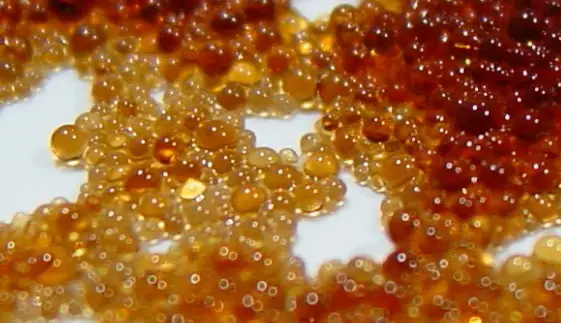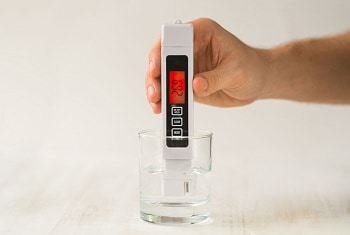You know that your water softener does a great job at softening your water, but you always have to add all that salt to the salt tank every month. Where is all that salt going? Are you drinking all that salt, and why does your water softener need the salt anyway?
Does A Water Softener Add Salt To My Drinking Water? A water softener does not add salt to the water to make the water soft. It uses the saltwater that is made in the salt tank to remove hard minerals from its softening resin so that the resin can remove more hard minerals from the water. The saltwater cleans off the resin and then is rinsed away.
Why does a water softener need salt anyway, and doesn’t adding salt to water make it softer? Read-on, to understand just what that salt is doing inside of your water softener.
What does the salt do?
A water softener uses salt, a little like a washing machine uses soap.
The water softener adds water to the salt to dissolve a portion of the salt, and then it uses the salty water to remove hard minerals from the water softening resin that it uses to remove hardness in your water.
You can think of a water softener softening resin a bit like a sponge. If you use a wet sponge to remove dirt from a surface, you will have to run it under water to clean it so that it is able to remove dirt once again.
The saltwater in a water softener system works a little like the water used to clean the sponge.
Of course, it is a bit different, during normal operation, water runs through the water softeners tank and through the resin inside of it.
As the water flows through the resin, minerals that are in the water cling to the water softening resin.

Eventually, the resin has so much mineral on it that it simply can’t remove any more. This is when the saltwater is used. When the saltwater runs over the water softening resin, the minerals drop off of the resin and get rinsed away.
This is because the water softening resin will hold sodium ions better than the hard minerals, and therefore will exchange the minerals for the sodium ions.
This process is called Ion exchange. Ion exchange is when ions are transferred from a solid to a solution or a solution to a solid. (Ion exchange)
Where does the salt go?
The salt that you put into your water softeners salt tank gets dissolved into water to create a brine. Brine is water that has dissolved as much salt into it as it can at the current water temperature.
This saltwater is flushed through the water softeners resin tank, and then out to a drain. During its trip through the water softeners resin, it picks up the collected hard minerals that have built-up on the water softeners resin.
It takes the minerals along with it and washes them away down the drain. Then, once all of the brine has been used up, the system runs clean water through to rinse the saltwater away.
Is any salt left behind?
During the ion exchange process, the hard ions that have been collected on the softening resin are replaced by sodium ions.
The majority of these sodium ions get rinsed away by the freshwater, and the amount of sodium left over is very small.
Most people never even taste that there is a difference between their softened water and their non-softened water. If your water softener is leaving your water tasting salty, it is not functioning correctly.
When a standard water softener is working correctly, the amount of sodium left behind is very small.
Can I test my water for extra salt left by my water softener?
If you are concerned that your water softener is leaving a large amount of salt behind after it has completed its regeneration process, You can easily test your water with a Total Dissolved Solids (TDS) Meter.

Your TDS meter will come to you already calibrated, so all that you have to do is test your water before it goes through your water softener, and compare the results to the cold water from your water faucet.
Simply turn on the cold water from your sink faucet (use a faucet that you use regularly for best results). Let the water run for 10 seconds, and then fill the TDS meter test cup with water.
Then turn your TDS meter on and dip the end of the meter into the sample cup and wait until the meter stops at its reading ( about 10 seconds is fine).
Write down this reading, and then test the un-softened cold water that is coming into your home in the same way.
Put a sample of your un-softened water (water that has not gone through your water softener) into the sample cup of your TDS meter.
You can get a sample of your un-softened water from your pressure tank, or simply put your water in bypass, and then run your cold water for a few minutes so there is no softened water coming out.
The difference between the two readings is the number of dissolved solids (salt) that has been left in your water after your water softener has regenerated.
A difference of as much as 25% is not uncommon, right after your water softener has regenerated, and this number will go down as you use water through the water softener.
If you find that the number of dissolved solids in your softened water is considerably higher than the number of dissolved solids in your un-softened water, your water softener may not be working correctly.
Why would my water softener leave a lot of salt behind after it regenerates?
If you have a pre-filter before your water softener, it may be clogged which will deprive your water softener of the water pressure that it needs to rinse away any extra salt after it regenerates.
There are filtering screens and injectors inside of a water softener that can cause salt to be left in your water if they get clogged.
These screens and injectors get clogged by debris getting into your water softener and from iron in your water. They can often be cleaned to allow them to work correctly. See your owners manual, as each brand of water softener will have these parts in different places.
How much sodium from salt will normally be added to my water?
A general rule of thumb is for every 1 Grain Per Gallon (GPG) of hardness in the water to be removed, there will be about 2 milligrams of sodium left behind per every 8 ounces of water.
For example, if your water hardness is 10 grains per gallon, 8 ounces of the water coming out of your water softener after it has regenerated would contain about 20 milligrams of sodium more than the water going into the water softener.
If 20 milligrams sounds like a lot, I can assure you that it really isn’t. A single teaspoon of salt contains 2,300 milligrams of sodium.
So you can see that a water softener that is working properly will not make your water significantly more salty at all.
Why do I taste salt in my water sometimes?
If water is being used elsewhere in the home, a water softener may not get all the water pressure that it needs to thoroughly rinse out the salt that is used to remove the hardness from its softening resin.
When this happens, some salt may be left behind, which will leave your water tasting salty until enough water has been used to rinse it away.
It is recommended to set your water softener to regenerate at a time when no water is being used in the home to provide the water softener with maximum water pressure to regenerate correctly.
How can I remove salt from my water?
The most reliable and economical way to remove excess salt from your drinking water is to get a recommended reverse osmosis drinking water system.
The process of reverse osmosis was developed specifically for the removal of salt from water, they are simple to use and very affordable.


Does it hurt to use your water softener without salt?
Hello Chuck, and thank you for the question.
A water softener will not be able to soften water without salt. Sodium ions are used to regenerate the water softening resin so that it is able to remove hardness from the water.
See my article What Happens If My Water Softener Runs Out Of Salt?
Hope you find it helpful
Paul
What about the brine going into the drain and ultimately the ocean?
Hello Edward and thank you for the question.
Of course, the brine that goes down the drain will have to end up somewhere, but the salt that created the brine was mined from the earth and after it was used by the water softener, it was returned to the earth. A water softener is not a perfect system but it is the best way to soften residential water.
Hope this was helpful.
Paul
Hello Paul,
My water softener empties into my septic tank. Will the brine be harmful to the landscape trees (200 year old oaks) that are around the septic drain field?
Thanks,
Hello Jim and thank you for the question.
Despite what some people say, the wastewater from a properly working water softener contains much less sodium than you might think.
In fact, studies by the Water Quality Research Foundation have shown that the discharge from a water softener has no significant negative effects on a septic system or the surrounding environment.
Even if your water is very hard and your water softener has to regenerate every day, the saltwater becomes very diluted during the regeneration process and then even more by the water used throughout the day.
You would have to have your water tested to be 100% sure that it will not harm your oaks and I am not an expert on trees, but I highly doubt that your water softener will harm your trees.
I hope this was helpful!
Paul